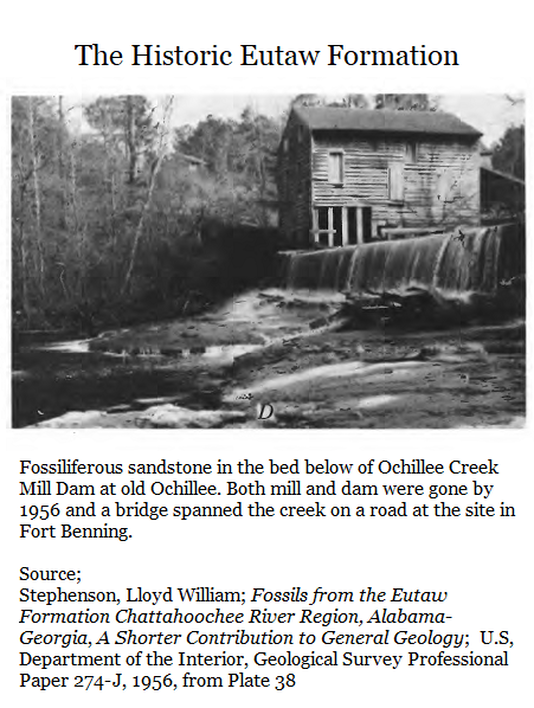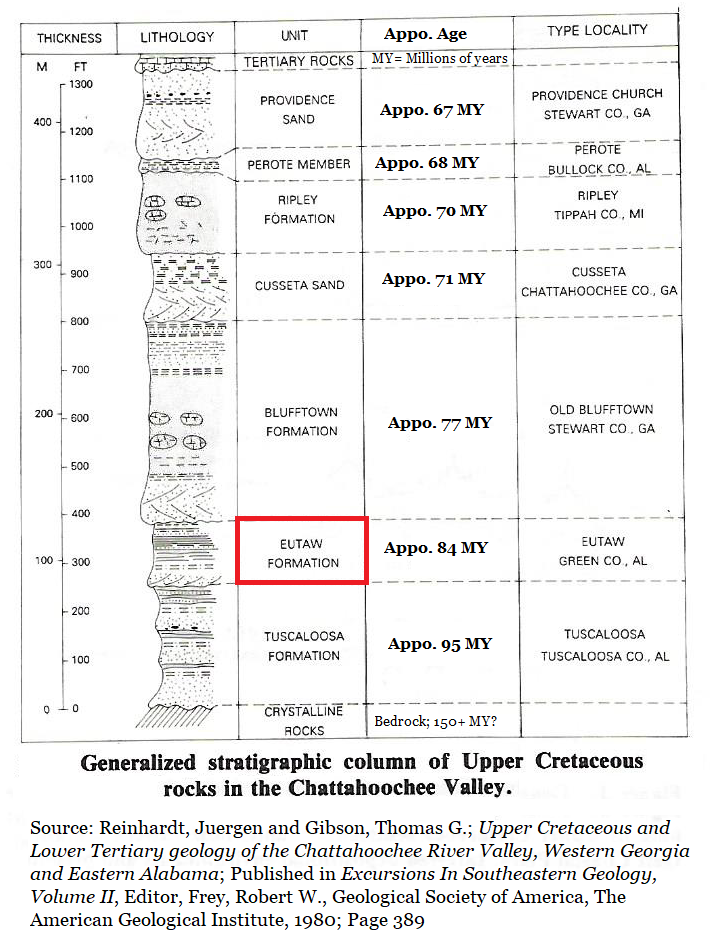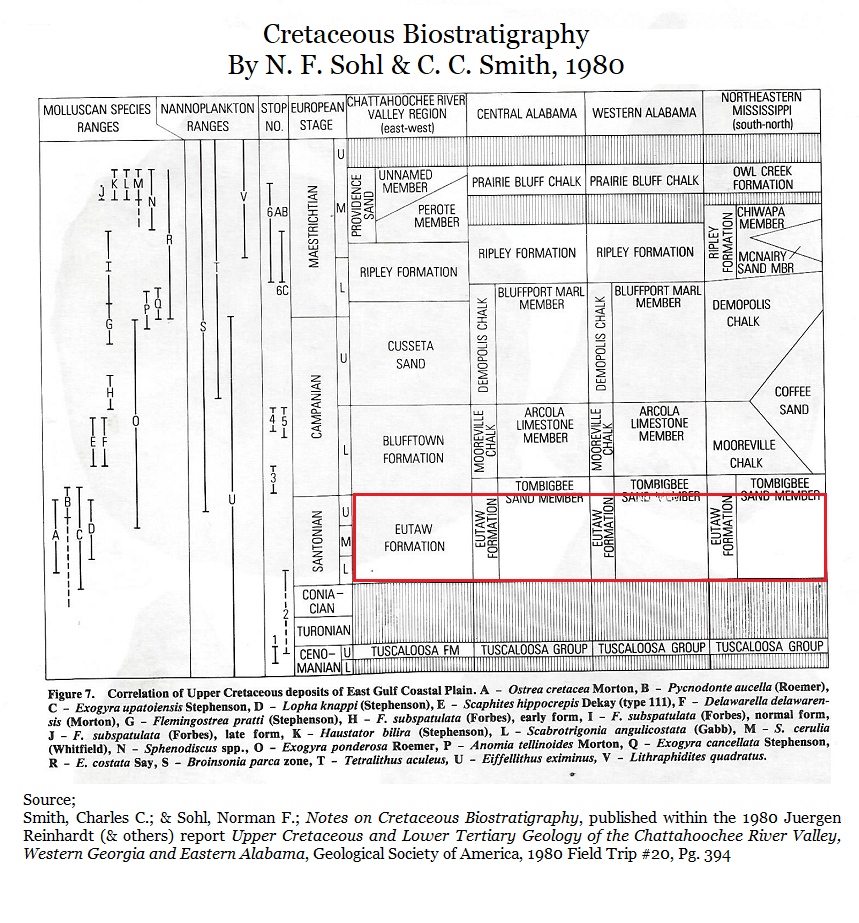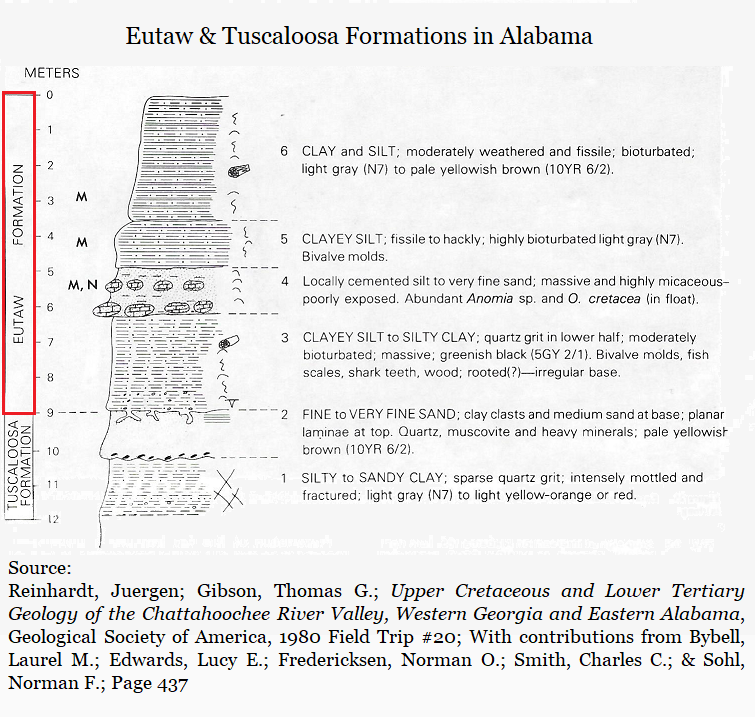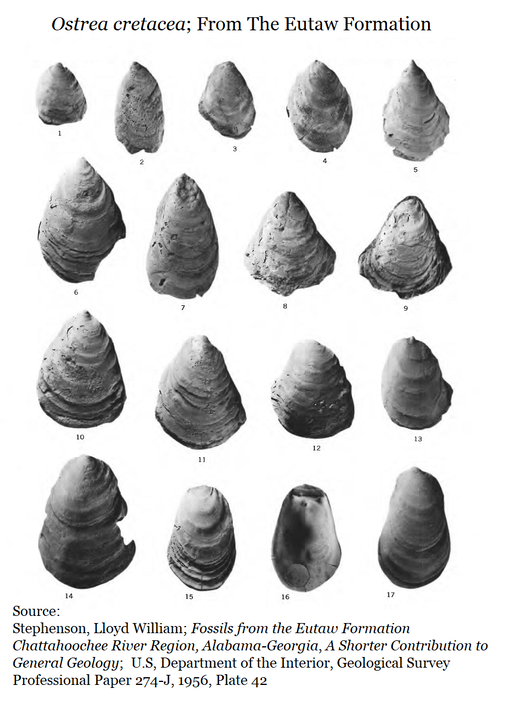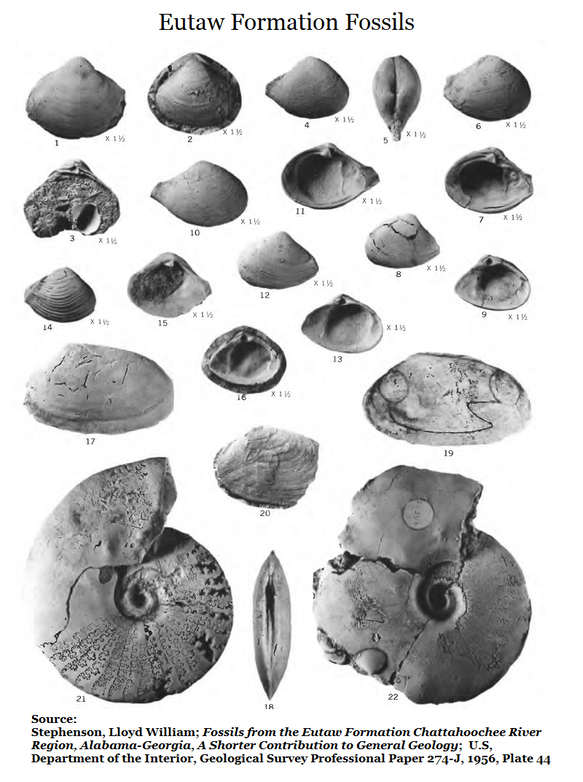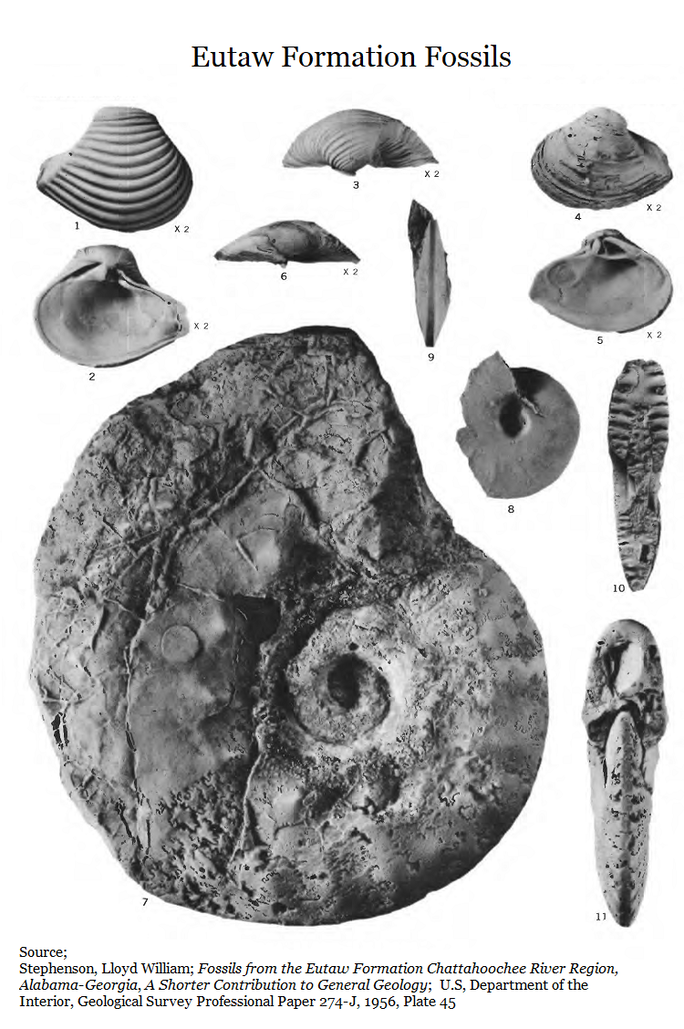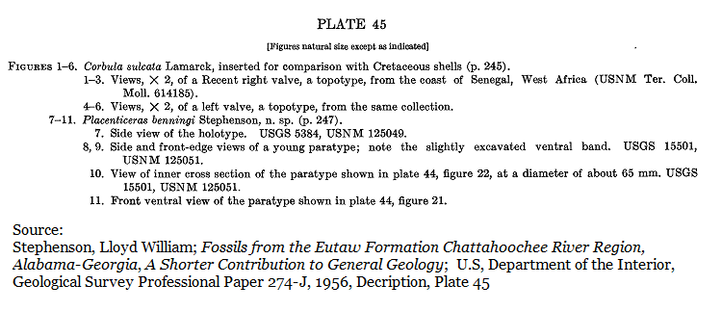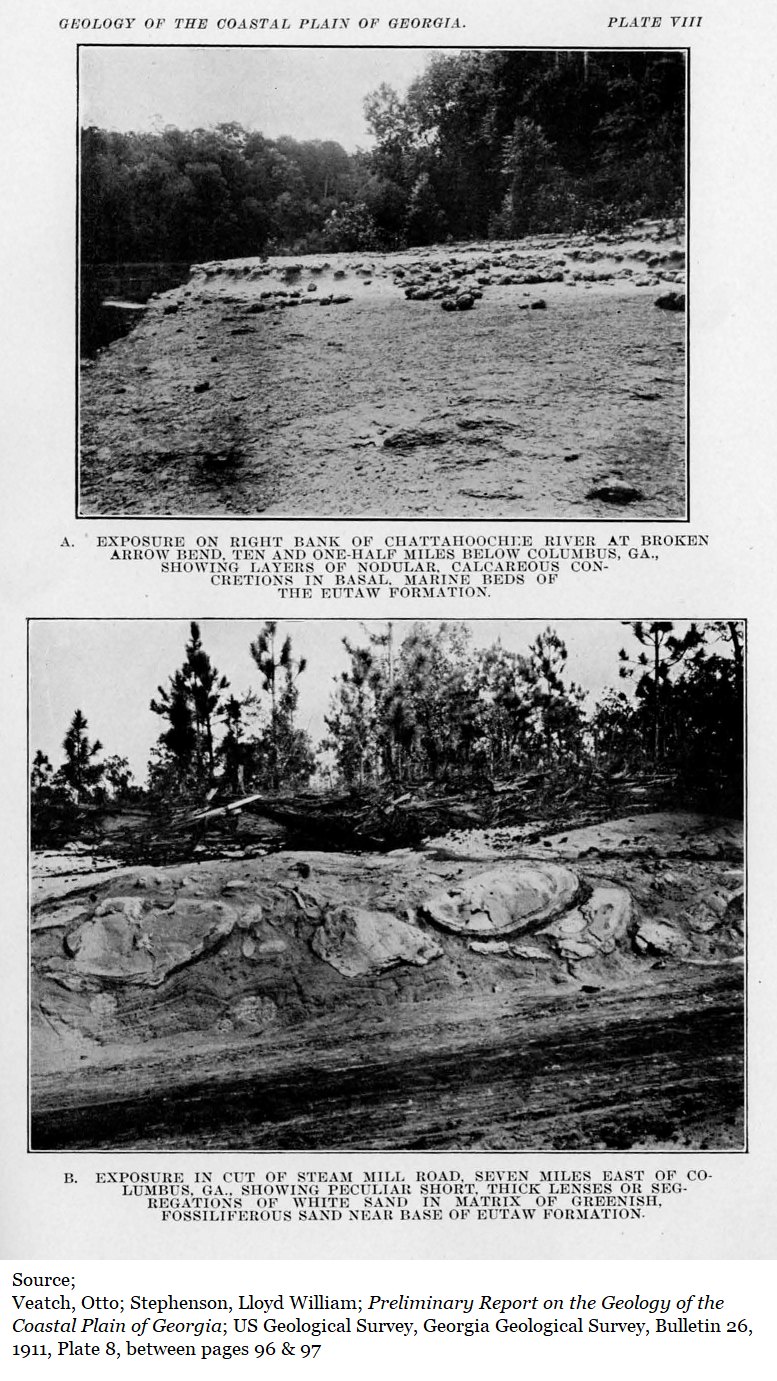7J: The Eutaw Formation
By Thomas Thurman
29/July/2021
The Eutaw Formation occurs between the Blufftown Formation and the Tuscaloosa Formations; the Blufftown is above it and the Tuscaloosa is below it. Juergen Reinhardt (1) and others reported in 1980 that it can be traced in outcrop from its type locality in western Alabama to east of Georgia’s Flint River, well into Georgia. Reinhardt’s research dated the Eutaw to 83.6 to 86.3 million years old; this is the Santonian age of the Cretaceous Period. More recent research has focused the Eutaw to approximately 84 million years old.
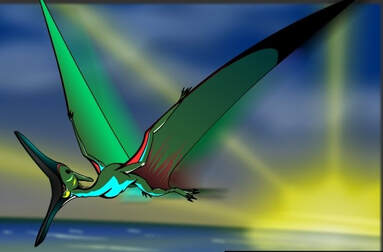
Georgia’s pterosaur, reported by David Schwimmer, came from the Eutaw Formation and remains one of its most famous and important fossils. That discovery is described in greater detail in Section 7A of this website.
The Eutaw Formation has long been recognized. In 1911, Otto Veatch & Lloyd Stephenson reported; “Considerable variation has been noted in the character of the materials of this formation, both vertically and horizontally. In the immediate Chattahoochee region they are in the main of marine origin, though a part of them was obviously laid down in very shallow marine waters, and some may even have originated in estuaries or sounds.”
The 1911 report continues to explain that east of the river and deeper into Georgia the formation becomes coarser and more irregularly bedded. This is in Chattahoochee, Marion and Taylor Counties. “Doubtless it originated in shallow water, near shore, or even in sounds and estuaries.”
Back towards the river Veatch & Stephenson report that the base of the formation consist of a few feet of coarse, feldspar-rich sandstone and mica-rich sand which resemble the underlying beds. There are lenses of drab to black, laminated, clay bearing leaf remains in places. Scattered through these sands are considerable quantities of plant fossils as lignite (brown coal); 84 million year old twiggs, branches and logs occur.
Above this is 50 feet of gray to dark gray sands and clays with scattered layers of nodular, impure limestone. The limestone is fossiliferous, often containing large numbers of marine shells and shell prints.
On the general paleontology of the Eutaw Formation I will again quote Veatch & Stephenson’s 1911 report….
“Paleontologic characters - Marine invertebrate fossils are numerous in the lower 100 feet of the formation. Near the immediate base these are preserved as shells, shell prints, and internal casts. In beds somewhat higher they appear only as casts and prints. In the next 300 feet or more invertebrate fossils are rare, but a few soft prints of shells have been observed.”
“Paleontologic characters - Marine invertebrate fossils are numerous in the lower 100 feet of the formation. Near the immediate base these are preserved as shells, shell prints, and internal casts. In beds somewhat higher they appear only as casts and prints. In the next 300 feet or more invertebrate fossils are rare, but a few soft prints of shells have been observed.”
“In the massive, marine sands and clays forming the upper 120 feet of the formation (Tombigbee Sand Member) invertebrate fossils are plentiful both as shells and as prints and casts.”
“Vertebrate animals are represented, so far as known, by the remains of sharks only. The teeth of these fishes are present in places in the massive, marine beds near the base, and in the Tombigbee sand member at the top of the formation.”
“Vertebrate animals are represented, so far as known, by the remains of sharks only. The teeth of these fishes are present in places in the massive, marine beds near the base, and in the Tombigbee sand member at the top of the formation.”
To quote his thoughts in 1956 after four decades of research… (3)
“The Eutaw formation is estimated to be about 200 feet thick in the Chattahoochee River region; it consists mainly of more or less argillaceous (clay-rich) and micaceous (Mica-rich) sand with interbedded layers of calcareous sandstone and concretions but includes some important and lenses of shale.”
“The Eutaw formation is estimated to be about 200 feet thick in the Chattahoochee River region; it consists mainly of more or less argillaceous (clay-rich) and micaceous (Mica-rich) sand with interbedded layers of calcareous sandstone and concretions but includes some important and lenses of shale.”
The thickness of the Eutaw is variable depending on location.
Stephenson continues to discuss and describe 16 species of invertebrates which occur in the Eutaw Formation, 15 of which are bivalves and one of which is an ammonite. Ten of these species were scientifically described by Stephenson.
Stephenson continues to discuss and describe 16 species of invertebrates which occur in the Eutaw Formation, 15 of which are bivalves and one of which is an ammonite. Ten of these species were scientifically described by Stephenson.
Invertebrate Species
The discussed species are listed below
Those described by Stephenson marked by an asterisk (*):
Pelecypods/Bivalves (clams)
Breviarca symmetros *
Cymbophora ochilleana *
Caryocorbulat veatchi * (Also in the Cusseta Sand)
Nucula prepercrassa *
Protarca obliqua * (Also in the Cusseta Sand)
Trigonarca inflata * (Also in the Cusseta Sand)
Venus clam
Lequmen carolinense (Also in the Cusseta Sand)
Cockle
Cardium ochilleanum *
Mussel
Pseudoptera securiformis *
Oyster
Anomia preolmstedi * (Also in the Cusseta Sand)
Exogyra upatoiensis*
Gryphaea wratheri *
Ostrea ucheensis *
Ostrea cretacea
Ammonite
Placenticeras benningi *
The discussed species are listed below
Those described by Stephenson marked by an asterisk (*):
Pelecypods/Bivalves (clams)
Breviarca symmetros *
Cymbophora ochilleana *
Caryocorbulat veatchi * (Also in the Cusseta Sand)
Nucula prepercrassa *
Protarca obliqua * (Also in the Cusseta Sand)
Trigonarca inflata * (Also in the Cusseta Sand)
Venus clam
Lequmen carolinense (Also in the Cusseta Sand)
Cockle
Cardium ochilleanum *
Mussel
Pseudoptera securiformis *
Oyster
Anomia preolmstedi * (Also in the Cusseta Sand)
Exogyra upatoiensis*
Gryphaea wratheri *
Ostrea ucheensis *
Ostrea cretacea
Ammonite
Placenticeras benningi *
Sadly, the damming of the Chattahoochee River at Fort Gaines, Georgia permanently submerged most of the known Eutaw Formation outcrops in Georgia.
Historic outcrops reported in 1956
The first exposure of the formation is in a low bluff on the Georgia side below the mouth of Upatoi Creek, 8.5 miles by the river below Columbus, and the last exposure is in a bluff on the Alabama side, 200 yards above the mouth of Uchee Creek, 16.5 miles below Columbus.
Stephenson repeated reports from his 1911 research with Veatch (4);
Historic outcrops reported in 1956
The first exposure of the formation is in a low bluff on the Georgia side below the mouth of Upatoi Creek, 8.5 miles by the river below Columbus, and the last exposure is in a bluff on the Alabama side, 200 yards above the mouth of Uchee Creek, 16.5 miles below Columbus.
Stephenson repeated reports from his 1911 research with Veatch (4);
Section on Upatoi Creek
A bluff on Upatoi Creek 7 miles southeast of Columbus, Ga., formerly (1908) exposed the section described below; the section is now largely concealed by vegetation. (1956)
Eutaw formation: Thickness in feet
Sand, marine, weathered brown, unconsolidated 5
Sand, fine, and clay, partly weathered, greenish-gray,
irregularly foliated 5
Sandstone, fine-grained, white. 1
Sand, fine, and clay, greenish-gray, irregularly foliated 2
Sand, argillaceous, dark greenish-gray 5
Sandstone, fine-grained, white 2
Clay, with irregular dark clay foliations, and lignite
fragments; includes discontinuous nodular limestone
layers and irregularly distributed calcareous
concretions; fossiliferous. 25
Unconformity, contact poorly exposed.
Tuscaloosa (member):
Sand, coarse, arkosic, crossbedd.ed, light-gray
streaked with yellow; includes subordinate layers
of sandy clay 22
Concealed to water level 21
Total thickness 88ft
A bluff on Upatoi Creek 7 miles southeast of Columbus, Ga., formerly (1908) exposed the section described below; the section is now largely concealed by vegetation. (1956)
Eutaw formation: Thickness in feet
Sand, marine, weathered brown, unconsolidated 5
Sand, fine, and clay, partly weathered, greenish-gray,
irregularly foliated 5
Sandstone, fine-grained, white. 1
Sand, fine, and clay, greenish-gray, irregularly foliated 2
Sand, argillaceous, dark greenish-gray 5
Sandstone, fine-grained, white 2
Clay, with irregular dark clay foliations, and lignite
fragments; includes discontinuous nodular limestone
layers and irregularly distributed calcareous
concretions; fossiliferous. 25
Unconformity, contact poorly exposed.
Tuscaloosa (member):
Sand, coarse, arkosic, crossbedd.ed, light-gray
streaked with yellow; includes subordinate layers
of sandy clay 22
Concealed to water level 21
Total thickness 88ft
Additional fossils, mostly poorly preserved, belonging to the following genera, have been identified from the Upatoi Creek locality:
Trigonarca
Pholadomya
Cardium,
Tellina?
Turritella
Anchura
Volutomorpha
Several species of shark teeth are present.
Trigonarca
Pholadomya
Cardium,
Tellina?
Turritella
Anchura
Volutomorpha
Several species of shark teeth are present.
Section on Ochillee Creek
Strata corresponding to the basal 25 feet of the Eutaw formation in the section on Upatoi Creek are exposed on Ochillee Creek at and near the site of the dam and the old mill at Ochillee, Chattahoochee County, and for several hundred yards both downstream and upstream from the dam site. The bridge of the present roadway is approximately at the site of the dam and mill. These beds are fossiliferous and include some fossils that are in a more complete state of preservation than those found at other Eutaw localities in the Chattahoochee area. Dr. David Schwimmer (Columbus State University) reported on 20/May/2023 that Ochillee Creek is still a productive site.
A list of the species described from Ochillee Creek is given below.
Protarca obliqua
Pseudoptera securiformis
Ostrea cretacea
Anomia preolmstedi
Legumen carolinense
Cymbophora ochilleana
Caryocorbula veatchi
Placenticeras benningi
In addition to the species Stephenson formally described, he also reportedfossils belonging to the following genera from Ochillee:
Serpula (tubes)
Idonearca
Pecten (Camptonectes*)
Etea
Cyprimeria,
Leptosolen
Turritella
Anchura
Strata corresponding to the basal 25 feet of the Eutaw formation in the section on Upatoi Creek are exposed on Ochillee Creek at and near the site of the dam and the old mill at Ochillee, Chattahoochee County, and for several hundred yards both downstream and upstream from the dam site. The bridge of the present roadway is approximately at the site of the dam and mill. These beds are fossiliferous and include some fossils that are in a more complete state of preservation than those found at other Eutaw localities in the Chattahoochee area. Dr. David Schwimmer (Columbus State University) reported on 20/May/2023 that Ochillee Creek is still a productive site.
A list of the species described from Ochillee Creek is given below.
Protarca obliqua
Pseudoptera securiformis
Ostrea cretacea
Anomia preolmstedi
Legumen carolinense
Cymbophora ochilleana
Caryocorbula veatchi
Placenticeras benningi
In addition to the species Stephenson formally described, he also reportedfossils belonging to the following genera from Ochillee:
Serpula (tubes)
Idonearca
Pecten (Camptonectes*)
Etea
Cyprimeria,
Leptosolen
Turritella
Anchura
Stephenson further reports in 1956;
“Both the dam and the water mill of former years have completely disappeared from the Ochillee locality. Upstream from the site of the dam there is now exposed in the bed of the creek marine argillaceous sand with irregularly distributed ovate concretions 4 to 8 inches in diameter; these concretions contain imprints and molds of fossils with films of adhering shell substance among which are many individuals of Pseudoptera securiformis & Placenticeras benningi.”
Stephenson’s goal in his 1956 paper was to not only describe new species, but to report species useful in dating and identifying the Eutaw Formation and thus allow researchers to orient themselves in the stratigraphy.
“Both the dam and the water mill of former years have completely disappeared from the Ochillee locality. Upstream from the site of the dam there is now exposed in the bed of the creek marine argillaceous sand with irregularly distributed ovate concretions 4 to 8 inches in diameter; these concretions contain imprints and molds of fossils with films of adhering shell substance among which are many individuals of Pseudoptera securiformis & Placenticeras benningi.”
Stephenson’s goal in his 1956 paper was to not only describe new species, but to report species useful in dating and identifying the Eutaw Formation and thus allow researchers to orient themselves in the stratigraphy.
Sharks & Their Kin
Below is the listing of Eutaw Formation sharks reported in 2001 by Gerard Case and David Schwimmer from Ochilee Creek in Southwest Georgia near the Alabama line (5).
Below is the listing of Eutaw Formation sharks reported in 2001 by Gerard Case and David Schwimmer from Ochilee Creek in Southwest Georgia near the Alabama line (5).
Ochilee Creek, Eutaw Formation in Georgia
Scientific Name Common Name
Borodinopristis Sawfish
Columbusia Shark
Chiloscyllium Bamboo Shark
Cretodus borodini Mackerel Shark family
Cretolamna appendiculata Mackerel Shark family
Erguitaia Ray or Skate
Hybodus Hump Toothed Shark
Ischyrhiza Sawfish
Ischyrhiza mira Sawfish
Lissodus babulskii Hybodont shark
Microdontaspis Carpet Shark/Wobbegong
Protoplatyrhina renae Skate
Pseudohypolophus Guitarfish
Ptychodus mortoni Extinct Shark (ate mollusks?)
Ptychotrygon Sawfish
Ptychotrygon triangularis Sawfish
Pycodont Bony Fish, known from Africa
Scapanorhynchus rhaphiodon Goblin Shark
Squalicorax falcatus Mackerel Shark family
Squatina hassei Angel Shark
Scientific Name Common Name
Borodinopristis Sawfish
Columbusia Shark
Chiloscyllium Bamboo Shark
Cretodus borodini Mackerel Shark family
Cretolamna appendiculata Mackerel Shark family
Erguitaia Ray or Skate
Hybodus Hump Toothed Shark
Ischyrhiza Sawfish
Ischyrhiza mira Sawfish
Lissodus babulskii Hybodont shark
Microdontaspis Carpet Shark/Wobbegong
Protoplatyrhina renae Skate
Pseudohypolophus Guitarfish
Ptychodus mortoni Extinct Shark (ate mollusks?)
Ptychotrygon Sawfish
Ptychotrygon triangularis Sawfish
Pycodont Bony Fish, known from Africa
Scapanorhynchus rhaphiodon Goblin Shark
Squalicorax falcatus Mackerel Shark family
Squatina hassei Angel Shark
References
- Reinhardt, Juergen; Gibson, Thomas G.; Upper Cretaceous and Lower Tertiary Geology of the Chattahoochee River Valley, Western Georgia and Eastern Alabama, Geological Society of America, 1980 Field Trip #20; With contributions from Bybell, Laurel M.; Edwards, Lucy E.; Fredericksen, Norman O.; Smith, Charles C.; & Sohl, Norman F.
- Smith, Charles C.; & Sohl, Norman F.; Notes on Cretaceous Biostratigraphy, published within the Reinhardt report Upper Cretaceous and Lower Tertiary Geology of the Chattahoochee River Valley, Western Georgia and Eastern Alabama, Pages392-402(See Reference #1)
- Stephenson, Lloyd William; Fossils from the Eutaw Formation Chattahoochee River Region, Alabama-Georgia, A Shorter Contribution to General Geology; U.S, Department of the Interior, Geological Survey Professional Paper 274-J, 1956
- Veatch, Otto; Stephenson, Lloyd William; Preliminary Report on the Geology of the Coastal Plain of Georgia; US Geological Survey, Georgia Geological Survey, Bulletin 26, 1911
- G. R. Case and D. R. Schwimmer. 2001. A New Selachian Fauna From the Eutaw Formation (Upper Cretaceous/Early to Middle Santonian) of Chattahoochee County, Georgia. Palaeontographica Abteilung A 261(Lfg. 4-6):83-102
